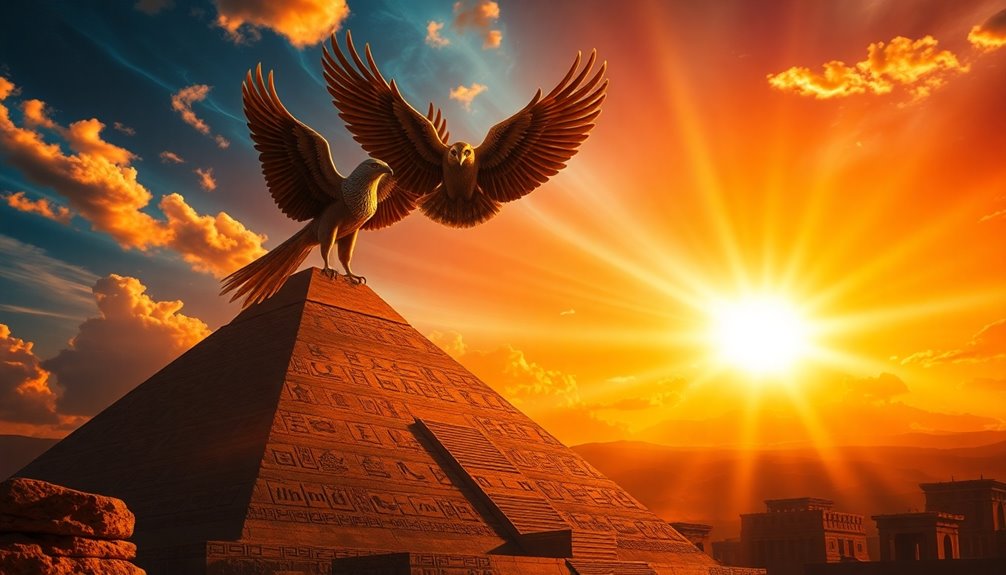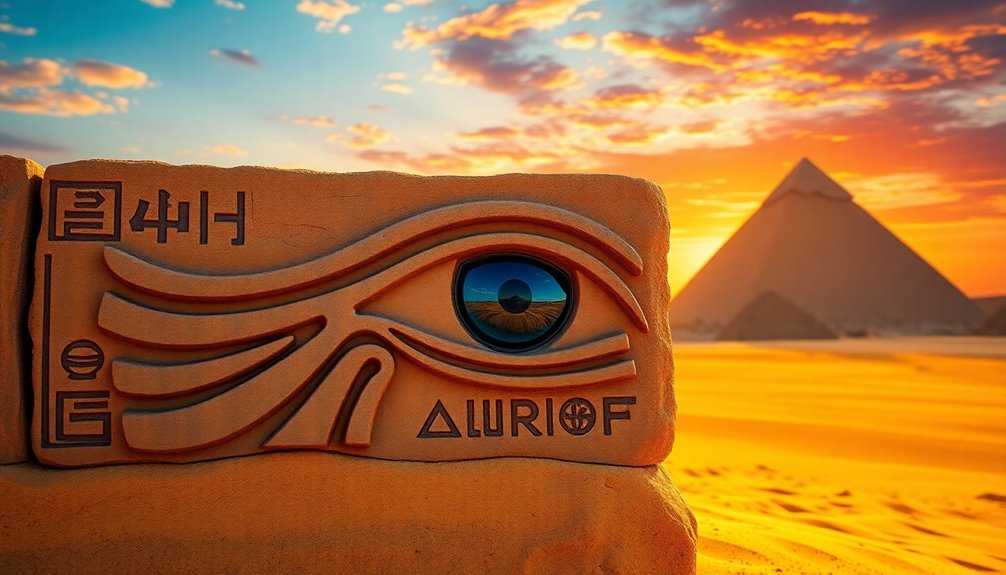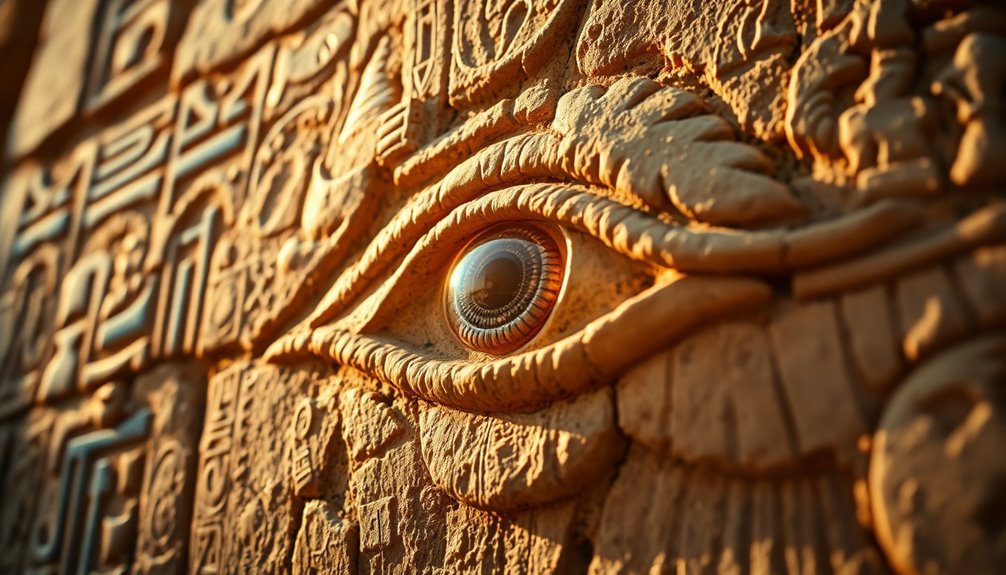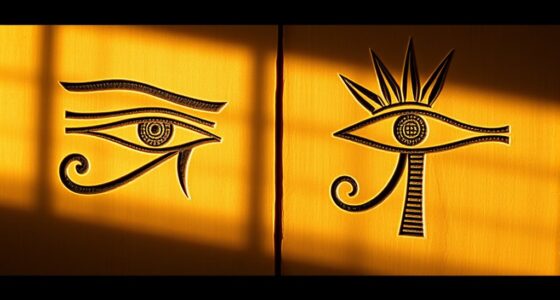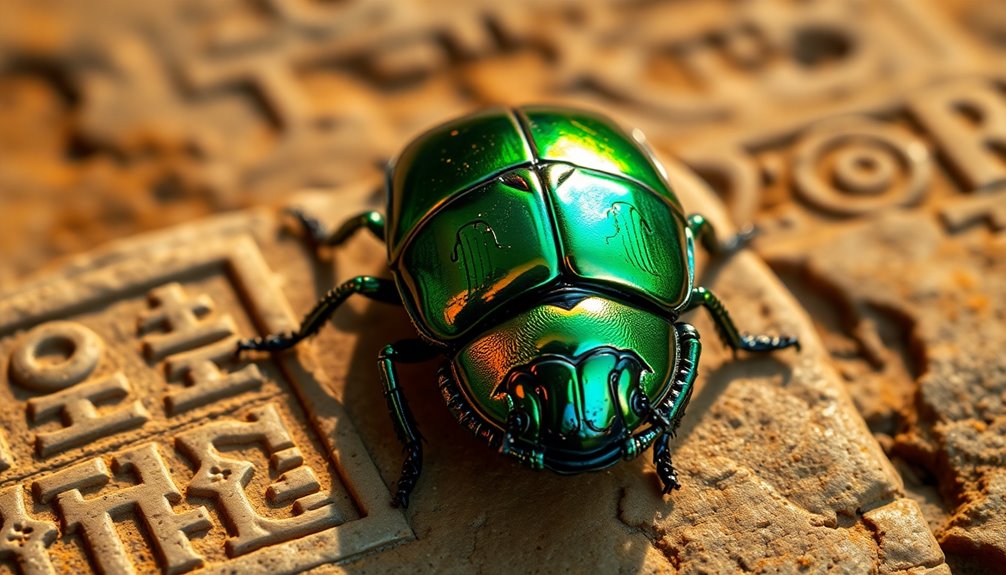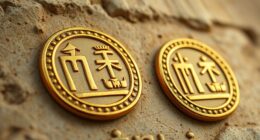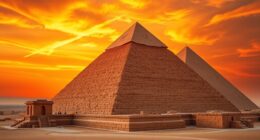When comparing Ra and Horus, you'll find both gods hold immense secrets tied to their powers. Ra, the sun god, symbolizes creation and life, with his secret name granting unparalleled strength. Conversely, Horus, the sky and kingship deity, embodies protection and justice, guarding the pharaohs and offering crucial insight into resurrection. While Ra represents the cycle of life and death, Horus's battles reflect themes of vengeance and royal authority. Their merging as Ra-Horakhty showcases their intertwined legacies. Each god has profound mysteries that influence not just mythology, but life itself. Discover the deeper connections behind their secrets.
Key Takeaways
- Ra holds the ultimate secret with his hidden name, representing immense power and knowledge within Egyptian mythology.
- Horus symbolizes justice and kingship, but does not possess a secret as powerful as Ra's hidden name.
- The struggle between Ra and Apep highlights Ra's authority over chaos, reinforcing his significance as a creator deity.
- Horus's battles against Set emphasize his role as protector, but they lack the cosmic implications tied to Ra's solar journey.
- The merging of Ra and Horus into Ra-Horakhty illustrates their interconnectedness, but Ra's secret remains paramount in their combined legacy.
Overview of Ra and Horus
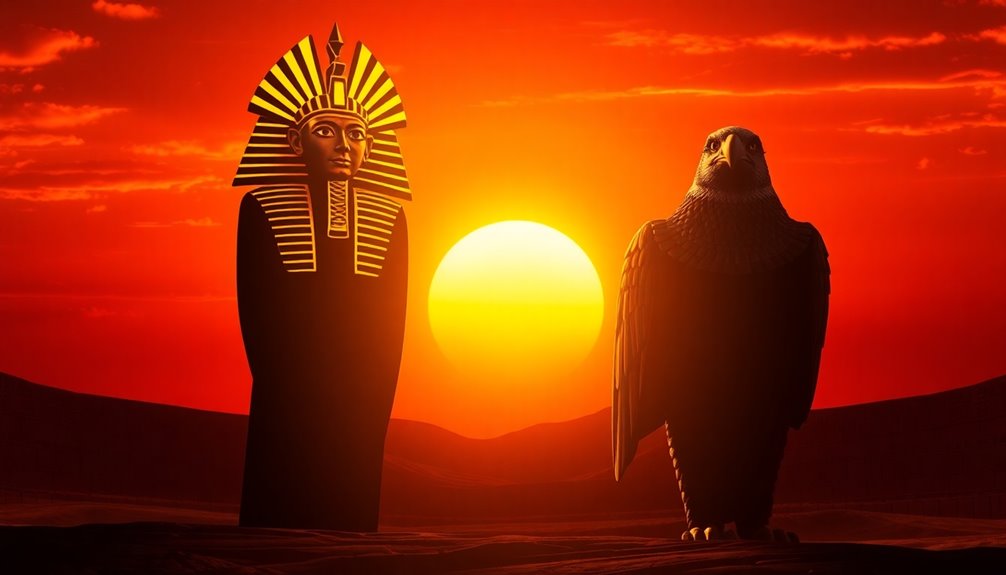
Ra and Horus are two of the most powerful gods in ancient Egyptian mythology, each symbolizing different aspects of life and the universe. Ra, revered as the chief deity, embodies the sun and creation, taking you on his daily journey across the sky. His cyclical nature represents life, death, and rebirth, making him central to Egyptian beliefs.
On the other hand, Horus, often depicted as a falcon or a man with a falcon head, symbolizes the sky, war, and kingship. You see him as the protector and avenger of pharaohs, emphasizing the divine legitimacy of their rule.
The merging of Ra and Horus into the syncretic deity Ra-Horakhty highlights their interconnectedness, blending their attributes and roles in worship.
Ra's eye, a symbol of solar protection, contrasts with Horus's right eye, linked to lunar aspects and often associated with healing. This connection forms a crucial part of amulets like the Udjat-eye, showcasing their protective powers.
Together, Ra and Horus play significant roles in the afterlife beliefs of ancient Egyptians, enriching your understanding of their spiritual domain.
Roles in Egyptian Cosmology
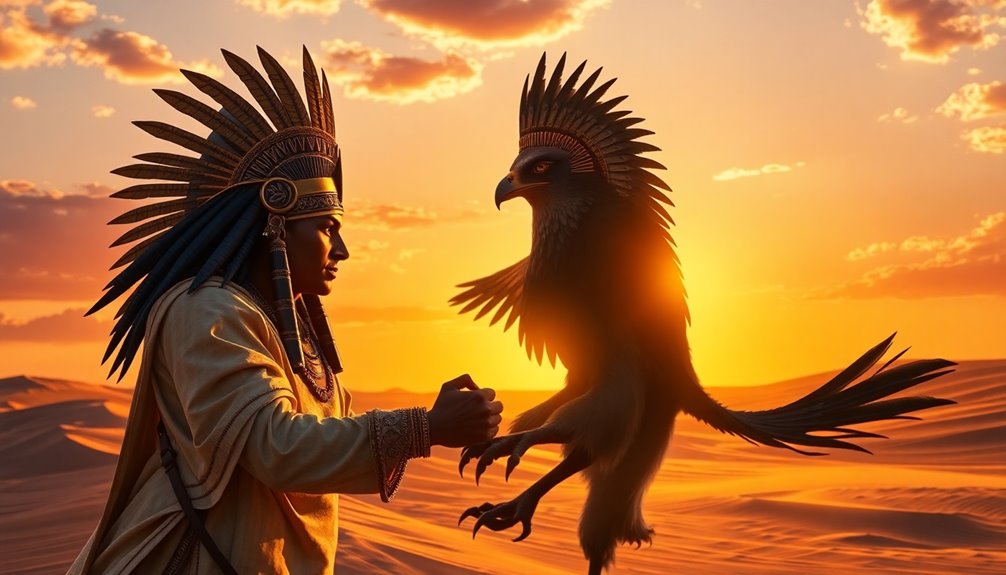
While exploring Egyptian cosmology, you'll find that Ra and Horus occupy pivotal roles that shape the understanding of life, death, and divine authority.
Ra is recognized as the creator deity and king of the gods, symbolizing light and life through his daily journey across the sky. His battle against the serpent Apep represents the eternal struggle between order and chaos, emphasizing the importance of balance in the universe.
On the other hand, Horus embodies the sky and kingship, serving as the protector of the pharaohs. His depiction as a falcon or a man with a falcon head highlights his connection to rightful rule and justice, particularly through his revenge against Set, which underscores the divine right to govern.
The merging of Ra and Horus into the composite deity Ra-Horakhty illustrates their interconnectedness in Egyptian cosmology. Together, they play essential roles in afterlife beliefs, with Ra's journey symbolizing the cycle of life and Horus ensuring the continuation of the pharaoh's legacy.
In understanding these roles in Egyptian cosmology, you grasp the complexity of their influence on ancient Egyptian society and spirituality.
Symbolism and Attributes
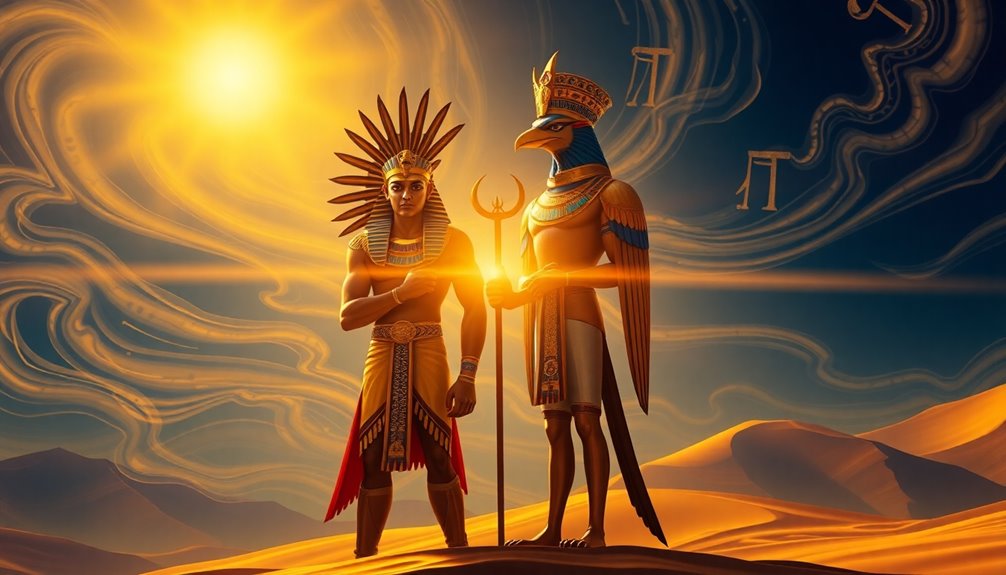
In ancient Egyptian belief, the symbolism and attributes of Ra and Horus intertwine to create a rich tapestry of divine significance. Ra, as the sun god, embodies light, life, and creation, representing the cyclical nature of existence through his daily journey across the sky. His attributes emphasize the importance of the sun in sustaining life and maintaining order.
On the other hand, Horus, often depicted as a falcon or a man with a falcon head, symbolizes kingship, protection, and vengeance, particularly concerning the pharaohs. The left eye of Horus signifies the lunar aspect and healing, while the right eye, linked to Ra, represents the solar aspect. Together, these eyes serve as powerful protective symbols in ancient Egyptian culture.
The merging of their attributes in the form of Ra-Horakhty reflects the syncretism of their divine roles. This connection highlights the significance of both the sun and the sky in Egyptian cosmology.
Additionally, the eyes of Ra and Horus often appear in amulets known as the Udjat-eye, symbolizing protection and the avenging powers of these deities against chaos and disorder.
Cultural Impact and Worship
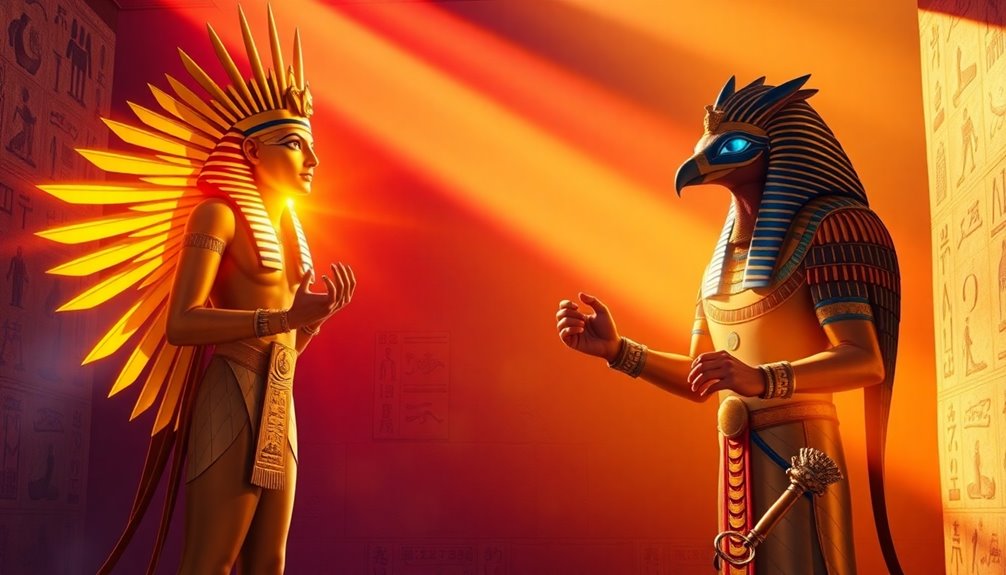
When you explore the worship practices of Ra and Horus, you'll notice distinct rituals and festivals that celebrated their divine roles.
These celebrations not only reinforced their importance in Egyptian society but also influenced other cultures through shared beliefs and customs.
Understanding their cultural impact reveals how deeply intertwined these deities were with daily life and governance in ancient Egypt.
Worship Practices Comparison
Throughout ancient Egyptian history, the worship practices of Ra and Horus reveal their profound cultural impact and significance. In your worship practices comparison, you'll notice that Ra was celebrated in grand temples like the Temple of Karnak. His festivals, such as Wepet-Renpet, marked the new year and symbolized life's renewal, emphasizing his role as the creator deity.
On the other hand, Horus was venerated primarily as a falcon, with the Temple of Edfu dedicated to him. His worship connected the pharaohs to his protective and avenging qualities, making him central to the divine right of kings.
Both Egyptian gods played essential roles in funerary practices, with Ra symbolizing the soul's journey across the sky and Horus avenging Osiris to reinforce resurrection themes. The Eye of Horus, an important amulet, represented protection and healing, while Ra's solar symbols were pivotal in rituals aimed at maintaining balance and harmony in life.
Elaborate rituals and processions during their festivals showcased their cultural impact, with Ra's celebrations highlighting the sun's life-giving properties, while Horus's festivities focused on kingship and the protection of the land.
Festivals Celebrating Deities
Festivals celebrating Ra and Horus played an essential role in ancient Egyptian culture, bringing communities together to honor these powerful deities.
These festivals dedicated to Ra, like the Wepet-Renpet, marked the New Year and celebrated the life-giving floods of the Nile, crucial for agriculture. Meanwhile, the Opet Festival recognized Horus in his form as Horus of Edfu, reinforcing the connection between the pharaoh and the divine.
During these vibrant celebrations, you'd experience:
- Joyful music and dance that filled the air, uniting people in shared devotion.
- Colorful processions that brought the divine presence closer to everyday life.
- Sacred rituals that sought blessings and protection from the Horus eye.
Temples dedicated to Ra and Horus became bustling centers of worship, where elaborate ceremonies reflected deep societal values and religious beliefs.
The Festival of the Opening of the Mouth symbolized the awakening of the deceased, highlighting both deities' roles in resurrection and continuity of life.
Engaging in these festivals wasn't just about tradition; it was a heartfelt plea for divine favor and a celebration of life itself.
Influence on Other Cultures
The vibrant festivals celebrating Ra and Horus not only strengthened community bonds in ancient Egypt but also laid the groundwork for their influence on other cultures. Ra's sun god attributes caught the attention of the Greeks, who merged his essence with their sun deity, Helios. This syncretism illustrates how religious beliefs can evolve and intertwine.
The goddess associated with both Ra and Horus, Isis, gained immense popularity across the Greco-Roman world, where people revered her for her protective and maternal qualities. Her influence even extended to figures like the Virgin Mary, showcasing her lasting impact.
In ancient Rome, the cult of Mithras adopted elements of Egyptian mythology, particularly the worship of solar deities, further blending religious practices. The Eye of Horus emerged as a potent symbol of protection and royal power, appearing in amulets and art throughout the Mediterranean.
This symbol's widespread appeal underscores the significance of Egyptian beliefs across various cultures. Festivals dedicated to Ra and Horus were celebrated not just in Egypt but also in Hellenistic cultures, highlighting their enduring legacy and the integration of these powerful deities into broader religious traditions.
Key Myths Involving Ra
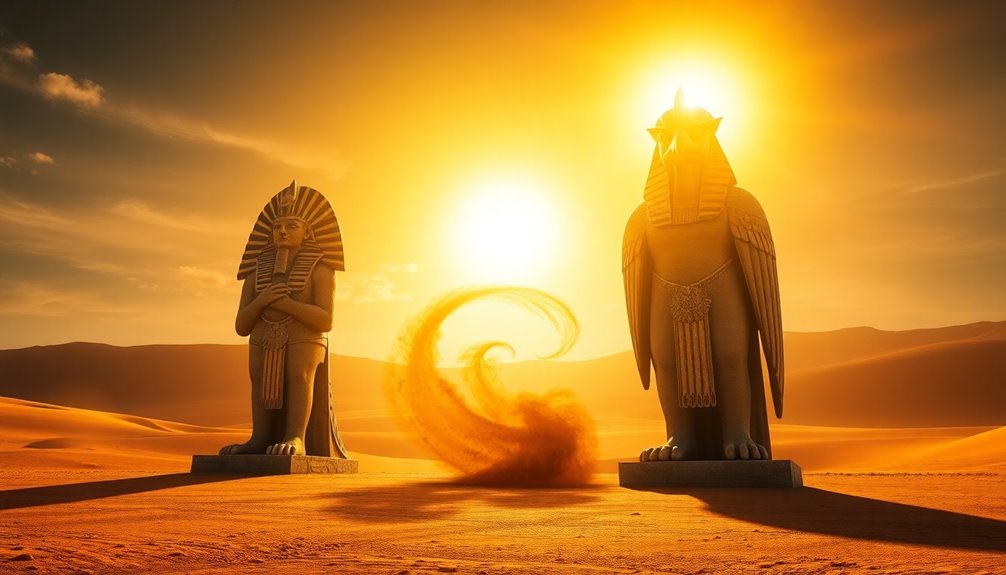
Several key myths highlight Ra's significance in Egyptian mythology and illustrate his powerful nature as a sun deity. His daily journey across the sky symbolizes the cycle of life and death, reinforcing his role as the creator of all life.
One myth features Ra battling the serpent Apep each night, showcasing the eternal struggle between order and chaos. This conflict emphasizes Ra's protective nature over the cosmos, instilling a sense of hope and security in ancient Egyptian culture.
- Ra's transformation into various forms, like a falcon and a ram, reveals his adaptability and multifaceted nature as a deity.
- The enchanting story of Ra's secret name illustrates the belief that knowing a god's true name grants immense power.
- Ra's solar disk atop his head symbolizes his unbreakable connection to the sun, marking him as a pivotal figure in the pantheon.
These key myths involving Ra not only define his character but also reflect the deep-rooted beliefs of ancient Egyptian culture, reminding you of the profound impact this sun god had on their worldview.
Key Myths Involving Horus
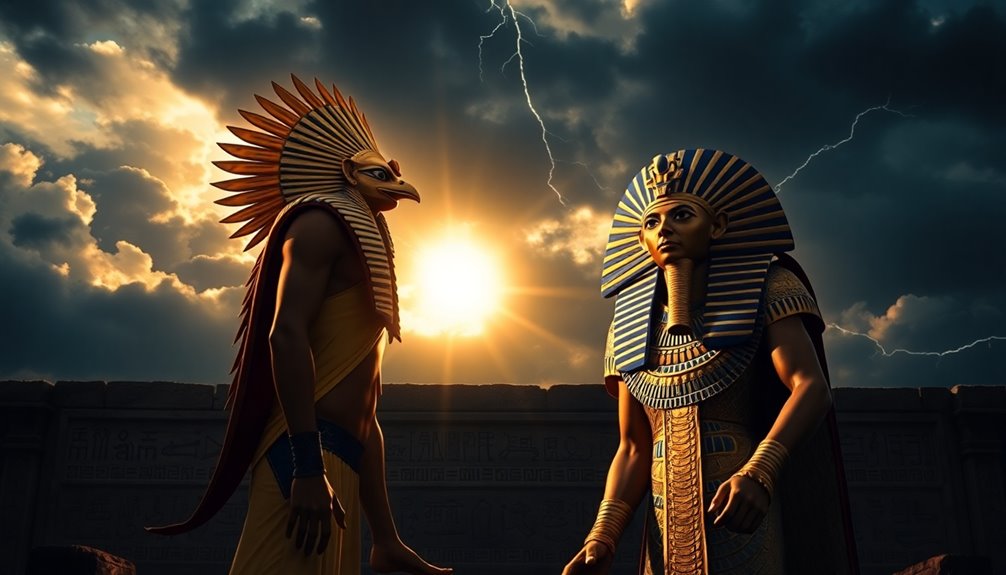
Horus stands as one of the most significant figures in Egyptian mythology, known primarily for his fierce battles against Set, the god of chaos. In these legendary conflicts, Horus seeks to avenge the death of his father, Osiris, embodying themes of justice and retribution. Their struggle isn't just a fight for supremacy; it symbolizes the rightful claim to kingship and the restoration of divine order.
One of the key myths tells of Horus losing his left eye during a confrontation with Set. This eye, later known as the Eye of Horus or Udjat-eye, transforms into a powerful symbol of healing and protection, reflecting the balance between life and death.
Horus's image, often depicted as a falcon or a man with a falcon head, emphasizes his connection to the sky and reinforces the divine rule of pharaohs.
In another enthralling tale, Horus resurrects Osiris, highlighting the cyclical nature of life and death. This act signifies rebirth and the enduring spirit of life, reminding you of the interconnectedness of existence in Egyptian beliefs.
Each myth surrounding Horus encapsulates the rich tapestry of ancient Egyptian spirituality.
Comparative Power Dynamics
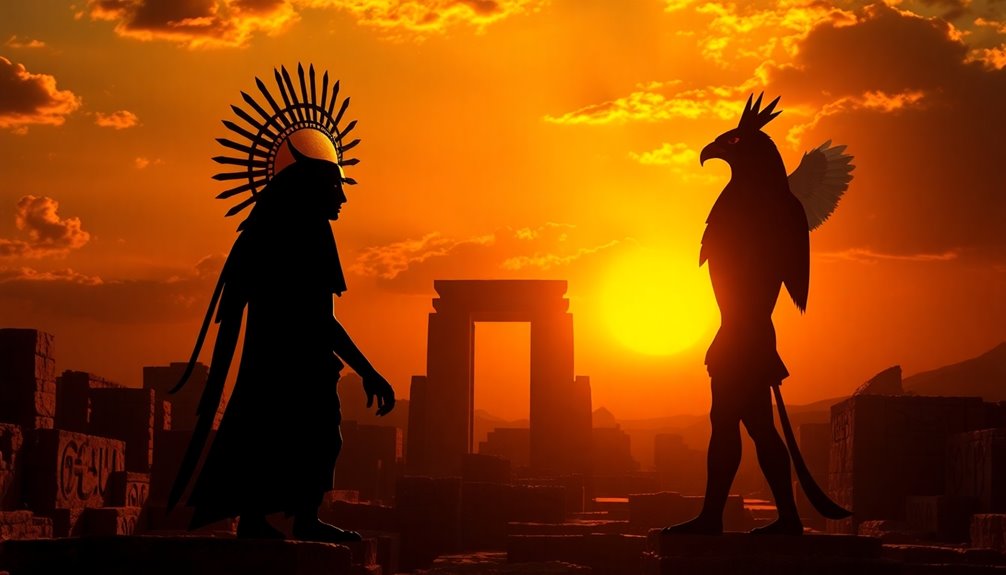
In examining the comparative power dynamics between Ra and Horus, it's clear that each deity holds a distinct yet interwoven role in Egyptian mythology. Ra, as the creator god, embodies life, death, and rebirth, earning a notable score of 6 out of 10 in power rankings. In contrast, Horus, the protector of pharaohs, garners immense respect through his association with kingship and vengeance, showcasing the duality of their powers.
- The weight of divine authority rests heavily on the pharaoh's shoulders.
- The tension between creation and protection fuels the cosmic balance.
- Each deity's influence shapes the narrative of Egyptian civilization.
Gods wouldn't merely coexist but compete for reverence and significance in a world where divine favor could determine the fate of nations.
Horus's avenging spirit against Set highlights his role as a fierce protector, while Ra's cosmic authority reinforces the foundational structure of the pantheon.
The interplay of these powers illustrates a competitive dynamic where legitimacy intertwines with mythological narratives, reminding us that even gods would navigate the complexities of influence and legacy.
Merging of Ra and Horus

When you explore the merging of Ra and Horus into Ra-Horakhty, you uncover a fascinating syncretism in worship that highlights the duality of their powers.
This composite deity embodies the solar force of Ra and the protective strength of Horus, showcasing how ancient Egyptians blended attributes for their spiritual needs.
Understanding this union reveals how these gods not only shaped religious practices but also reinforced the pharaoh's authority in society.
Syncretism in Worship
The merging of Ra and Horus into the deity Ra-Horakhty marks a significant evolution in ancient Egyptian worship, illustrating how two powerful gods can combine their attributes to enhance spiritual and political authority.
This syncretism in worship not only symbolizes the integration of Ra's solar aspects with Horus's kingship and protective qualities but also reflects the changing dynamics within ancient Egyptian society.
By embracing Ra-Horakhty, the pharaohs could legitimize their rule, showcasing their divine connection to both the sun and the heavens.
Festivals dedicated to Ra-Horakhty brought communities together, celebrating the life-giving force of the sun while honoring the protective nature of Horus.
- Feel the warmth of the sun's rays, instilling hope and liveliness.
- Embrace the strength of a falcon soaring high, symbolizing protection and power.
- Experience the unity of two powerful deities, merging their divine essence for a greater purpose.
This syncretism highlights the fluidity of ancient Egyptian belief systems, allowing followers to deepen their understanding of the cosmos and the divine roles of Ra and Horus in their lives.
Duality of Powers
Throughout ancient Egyptian mythology, the merging of Ra and Horus into Ra-Horakhty illustrates a powerful duality of divine attributes that shaped the spiritual landscape. By combining Ra's solar essence with Horus's sky and kingship qualities, this syncretism reflects the intricate relationship between creation, protection, and authority.
Ra, as the sun god, represents life-giving energy, while Horus, the avenger of his father Osiris, stands for kingship and safeguarding the domain. This duality of powers is further emphasized through their iconic symbols—the left eye of Horus, embodying the lunar aspect, and the right eye, representing Ra.
Together, they act as cosmic protectors, showcasing how these gods interconnect in their protective and avenging roles within the pantheon. The integration of Ra and Horus not only highlights the fluidity of ancient Egyptian beliefs but also mirrors the shifting political and social landscapes of the civilization.
Celebrations and rituals dedicated to both gods reinforce their significance in maintaining cosmic order and kingship. In this union, you see a profound balance of forces, embodying the essence of ancient Egyptian spirituality.
Legacy in Modern Culture

Ra and Horus continue to resonate in modern culture, shaping our understanding of power, justice, and protection. Their rich mythology inspires various forms of art, literature, and film, where themes of light versus darkness and rightful kingship thrive.
In today's modern world, Ra's image as the sun god symbolizes energy and strength, making appearances in branding and media. Horus, as the protector of the pharaohs, has transformed into a beacon of leadership and justice, often invoked in political conversations that address rightful authority.
- The eye of Horus, a symbol of protection and healing, signifies resilience, enchanting many through jewelry and tattoos.
- Ra's solar energy evokes feelings of warmth and power, encouraging us to embrace our inner strength.
- The legacy of Isis embodies female empowerment, inspiring a wave of artistic expressions that celebrate spirituality.
These symbols and themes from ancient mythology remind us of the enduring influence Ra and Horus have in shaping values and ideals in our modern culture, guiding our quest for identity and meaning.
Frequently Asked Questions
Is Ra the Most Powerful Egyptian God?
You might think Ra is the most powerful Egyptian god, and while he's a central figure in mythology as the sun deity, he isn't the strongest.
Historians rank him a 6 out of 10, indicating his significant influence, but not unmatched. Other deities, like Isis, overshadow him due to their magical prowess and control over life and death.
Ra's importance is undeniable, yet he's part of a broader pantheon of powerful gods.
Is Ra One of the Most Powerful Gods?
Yes, Ra is definitely one of the most powerful gods in ancient Egyptian mythology.
You'll find that he represents light, creation, and life, which underscores his significance. His daily journey across the sky symbolizes the cycle of life and death, while his battles against chaos, particularly against Apep, highlight his role in maintaining order.
Temples dedicated to him further emphasize his central position in religious practices and beliefs, making him a formidable deity.
Which Egyptian God Is Most Powerful?
When you think of the most powerful Egyptian god, imagine a swirling tempest of magic and might!
Isis stands supreme, wielding life and death like a master conductor. She's the ultimate sorceress, scoring a perfect 10 on the power scale.
In comparison, Ra and Horus, both ranked at 6, shine brightly but can't match her sheer force. Their roles are essential, but Isis' influence reigns supreme in the pantheon of Egyptian deities.
How Does Horus Compare to Ra?
When you compare Horus to Ra, you see two distinct yet interconnected gods.
Horus embodies kingship and protection, often linked to the pharaohs and resurrection themes. In contrast, Ra represents the sun, creation, and the eternal struggle against chaos.
While Horus's focus is on legitimacy and avenging his father, Ra's narrative revolves around the cycles of life and death.
Together, they illustrate the rich complexity of ancient Egyptian beliefs and their essential roles in mythology.
Conclusion
In exploring the powerful gods Ra and Horus, you discover their deep roots in Egyptian cosmology and culture. Notably, over 1,000 deities were worshipped in ancient Egypt, yet Ra and Horus often stood at the forefront of religious practices. Their merging and shared attributes illustrate how intertwined their legacies have become. Ultimately, whether you favor Ra's solar might or Horus's royal prowess, both gods hold secrets that shaped a civilization and continue to inspire modern culture.

